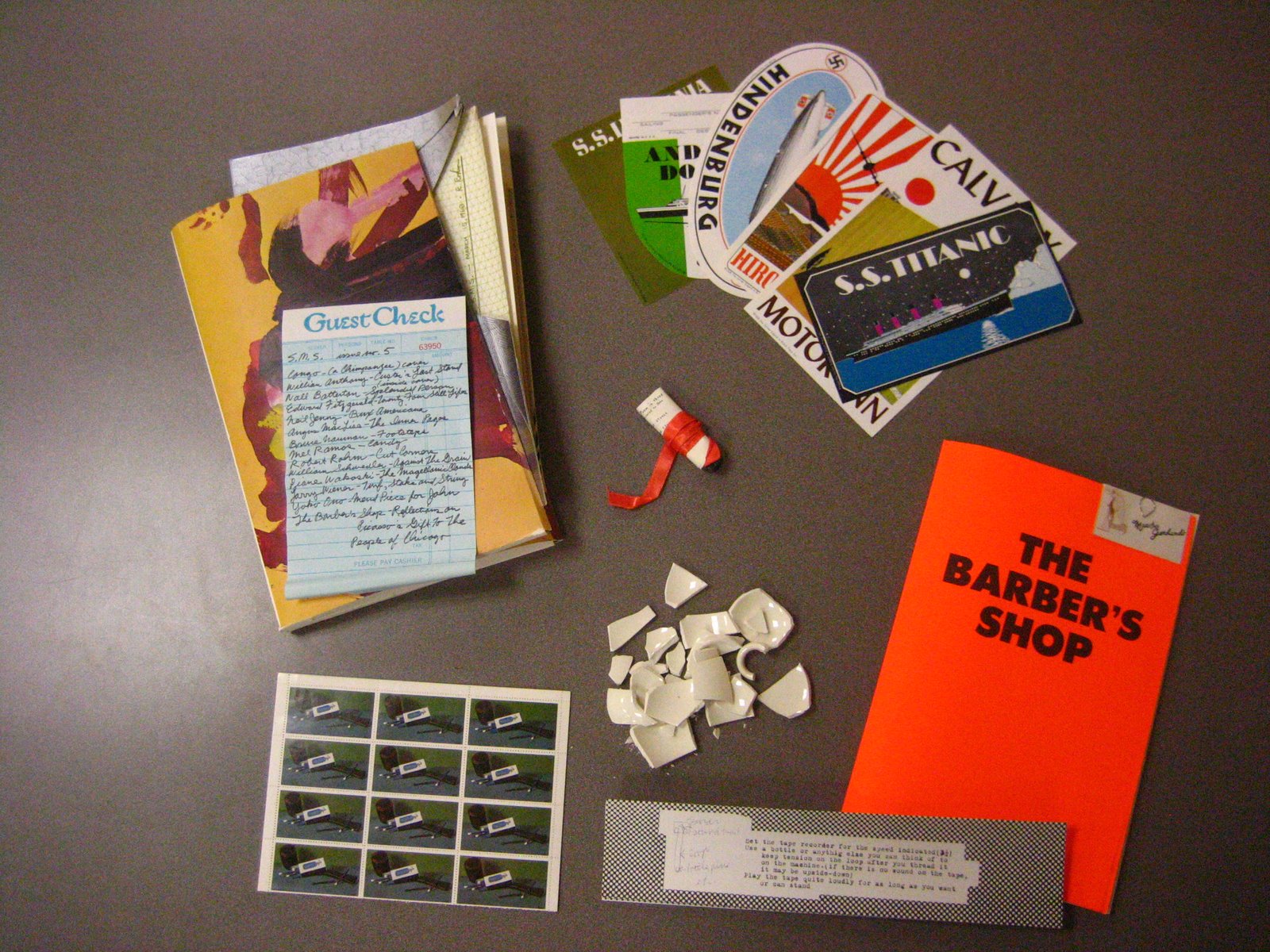S.M.S., William Copley, Letter Edged in Black Press, Inc., 1968
November 16, 2007
Description by Katie Hargrave, graduate student in Cultural Production
 At Brandeis we are lucky to have a complete set of the rare, serial-box surrealist publication conceived by New York artist William N. Copley (1919-1996) and known by the acronym S.M.S. (Shit Must Stop). The work is a series of folders, available by subscription, containing objects and artworks contributed by artists such as Marcel Duchamp, Ray Johnson and Man Ray. As a publication, its mission was to question the notion of art objects as belonging in museums and galleries by bringing the work to the fingertips of the subscribers. S.M.S. was produced in small runs, and the sets Copley, clearly an archivist at heart, donated to the New Museum of Contemporary Art were destroyed in a flood (Heller, 150). So why is this publication important to look at?
At Brandeis we are lucky to have a complete set of the rare, serial-box surrealist publication conceived by New York artist William N. Copley (1919-1996) and known by the acronym S.M.S. (Shit Must Stop). The work is a series of folders, available by subscription, containing objects and artworks contributed by artists such as Marcel Duchamp, Ray Johnson and Man Ray. As a publication, its mission was to question the notion of art objects as belonging in museums and galleries by bringing the work to the fingertips of the subscribers. S.M.S. was produced in small runs, and the sets Copley, clearly an archivist at heart, donated to the New Museum of Contemporary Art were destroyed in a flood (Heller, 150). So why is this publication important to look at?
Besides the breathtaking images and objects reproduced, Copley has given the subscriber a chance to interact directly with important contemporary artists such as Yoko Ono, Christo and Roy Lichtenstein (among others) and their works, including smashed tubes of paint, audio recordings, drawings, letters and even pill casings. Every aspect of the “magazine” is well designed and faithfully reproduced. The artists included were given only $100 for their contributions (the same as the price of the magazine), but every measure was taken to painstakingly reproduce the work, making the experience of looking through the set an incredibly tactile one.
 Copley himself only contributed an artwork once. The folio “The Barber's Shop” shows a series of documents and letters between Maestro Gerhard Nonmemacher, the City of Chicago, and Pablo Picasso regarding a copyright suit between Nonmemacher’s barber shop and the city for reproducing a drawing of Picasso’s public sculpture on his business cards. Nonmemacher writes (and Copley reproduces): “please tell me that you have no objection to my using your lady on the enclosed card, and please tell me that she truly belongs to all the people of Chicago for their use and enjoyment.” Copley’s interest in this case has everything to do with his beliefs about art and democracy, as he was interested in pushing the boundaries of art and the audience’s encounter with objects.
Copley himself only contributed an artwork once. The folio “The Barber's Shop” shows a series of documents and letters between Maestro Gerhard Nonmemacher, the City of Chicago, and Pablo Picasso regarding a copyright suit between Nonmemacher’s barber shop and the city for reproducing a drawing of Picasso’s public sculpture on his business cards. Nonmemacher writes (and Copley reproduces): “please tell me that you have no objection to my using your lady on the enclosed card, and please tell me that she truly belongs to all the people of Chicago for their use and enjoyment.” Copley’s interest in this case has everything to do with his beliefs about art and democracy, as he was interested in pushing the boundaries of art and the audience’s encounter with objects.
The serial lasted only six issues, and Brandeis has perfect-condition samples of each.
References
Heller, Steven. “Serial-Box Surrealism.” Print, no. 2, 2007: 148–153.